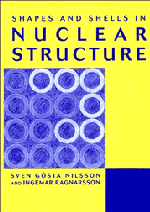Book contents
- Frontmatter
- Contents
- Preface
- 1 Naturally occurring and artificially produced nuclei
- 2 Charge and matter distribution in nuclei
- 3 The semi-empirical mass formula and nuclear stability
- 4 Nuclear fission and the liquid-drop model
- 5 Shell structure and magic numbers
- 6 The nuclear one-particle potential in the spherical case
- 7 The magnetic dipole moment and electric quadrupole moment for nuclei with closed shells ±1 nucleon
- 8 Single-particle orbitals in deformed nuclei
- 9 The shell correction method and the nuclear deformation energy
- 10 The barrier penetration problem – fission and alpha-decay
- 11 Rotational bands – the particle–rotor model
- 12 Fast nuclear rotation – the cranking model
- 13 The nucleon–nucleon two-body interaction
- 14 The pairing interaction
- Solutions to exercises
- References
- Index
12 - Fast nuclear rotation – the cranking model
Published online by Cambridge University Press: 12 January 2010
- Frontmatter
- Contents
- Preface
- 1 Naturally occurring and artificially produced nuclei
- 2 Charge and matter distribution in nuclei
- 3 The semi-empirical mass formula and nuclear stability
- 4 Nuclear fission and the liquid-drop model
- 5 Shell structure and magic numbers
- 6 The nuclear one-particle potential in the spherical case
- 7 The magnetic dipole moment and electric quadrupole moment for nuclei with closed shells ±1 nucleon
- 8 Single-particle orbitals in deformed nuclei
- 9 The shell correction method and the nuclear deformation energy
- 10 The barrier penetration problem – fission and alpha-decay
- 11 Rotational bands – the particle–rotor model
- 12 Fast nuclear rotation – the cranking model
- 13 The nucleon–nucleon two-body interaction
- 14 The pairing interaction
- Solutions to exercises
- References
- Index
Summary
At very high spin, one expects the Coriolis and centrifugal forces to disturb strongly the wave functions of many nucleons. As discussed in the introduction to the previous chapter, it then becomes desirable to treat all nucleons on the same footing.
In this chapter, we will introduce two models of this kind, namely the cranking model and the rotating liquid-drop model. The cranking model is first applied to the simple harmonic oscillator potential to illustrate some different concepts. Then the Nilsson–Strutinsky cranking approach corresponding to a combination of the two models is introduced. Within this approach, phenomena like band terminations and superdeformed high-spin states are discussed.
The cranking model
In the cranking model, the rotation is treated in the classical sense with the rotation vector coinciding with one of the main axes of the nucleus. It then turns out that, in this system, the nucleons can be described as independent particles moving in a rotating potential. In fact, the rotation degree of freedom enters in very much the same way as the deformation degrees of freedom, which were introduced in chapters 8 and 9. One important shortcoming of the cranking model is that the wave functions are not eigenstates of the angular momentum operator. Instead, the angular momentum is generally identified with the expectation value of its projection on the rotation axis.
- Type
- Chapter
- Information
- Shapes and Shells in Nuclear Structure , pp. 206 - 258Publisher: Cambridge University PressPrint publication year: 1995



